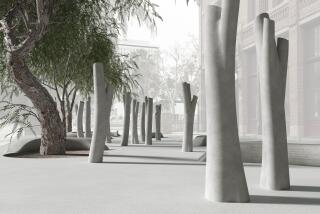Obituary : Geoffrey Jellicoe; Garden and Landscape Designer
- Share via
LONDON — Leading landscape architect Sir Geoffrey Jellicoe, who designed the John F. Kennedy memorial near London and the yet-to-be-built Moody Historical Gardens in Galveston, Texas, has died. He was 95.
Jellicoe died in Devon, in southwest England, on Wednesday, his family said.
He set out to become an architect but became interested in landscape when he and a fellow student, J.C. Shepherd, toured Italy to study its famous gardens. They co-authored a book about the gardens in 1925.
Jellicoe’s career spanned 70 years, and he was knighted in 1979. His work ranged from designing grand gardens for stately homes--including Queen Elizabeth II’s at Sandringham, 95 miles northeast of London--to town planning projects and the landscaping of industrial sites.
In 1964, he was commissioned to design the British memorial to Kennedy.
Influenced by Swiss psychologist Carl Jung’s ideas on symbolism and the workings of the conscious and subconscious, Jellicoe designed the Kennedy memorial site at Runnymede, 20 miles west of London, as a place of pilgrimage and contemplation.
Visitors follow a path along a wooded hillside to emerge at a light-filled clearing and a simple memorial stone.
A short, round-faced man with a quiet manner, Jellicoe published a number of books, including “The Landscape of Man” in 1975, which he co-wrote with his wife, Susan. The couple also edited the encyclopedic “Oxford Companion to Gardens” shortly before her death in 1986.
At age 80, Jellicoe came out of retirement to redesign the grounds of Sutton Place, the 16th century mansion near London formerly owned by American oil millionaire John Paul Getty, who died in 1976.
The success of the Sutton Place project brought Jellicoe commissions from around the world, including the Moody gardens.
Jellicoe called the Moody project “the summary of my life’s work.” Inspired by “The Landscape of Man,” the $30-million development will include 25 acres of gardens set in 126 acres of sea marshes between an abandoned airfield and the Gulf of Mexico.
Intended to invoke the history of landscape, it will include a vision of the biblical Garden of Eden, replicas of the gardens of ancient Egypt and Rome, and areas in the style of China and Japan.
Plants and architecture will be as historically accurate as possible. Visitors will travel by boat, taking in 15 garden cultures--some formal, others featuring rolling romantic landscapes, with waterfalls, caves and carved monsters.
Construction is scheduled to begin in the next few years.


